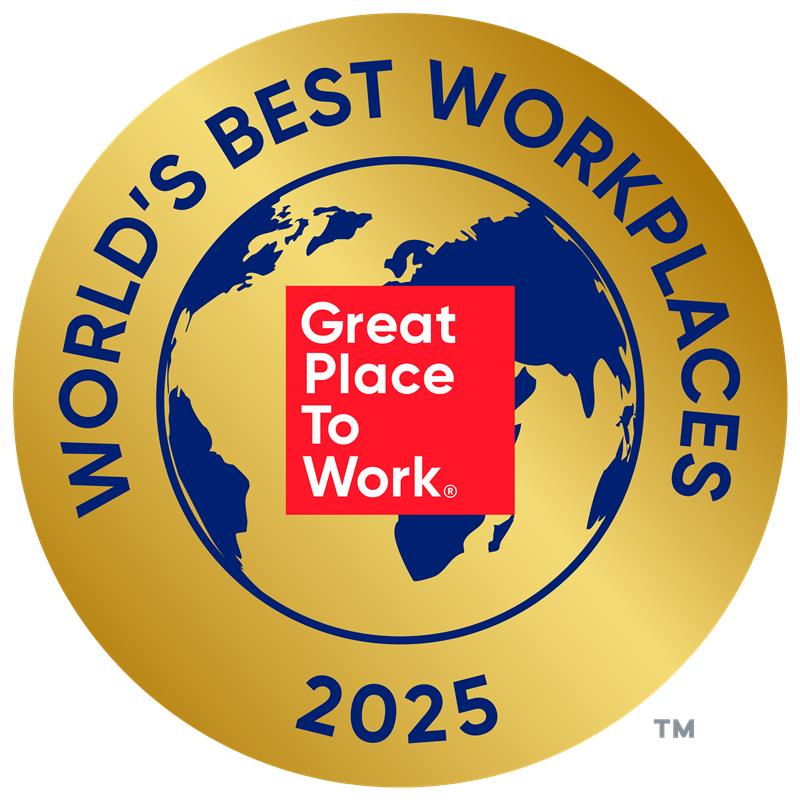
At Experian, we often say our people are our biggest superpower – and today, I’m thrilled to share that this belief has been recognised once again. Experian has been named one of the 2025 World’s Best Workplaces™ by Fortune and Great Place to Work® for the second year in a row.
This achievement reflects the culture we’ve built together – one that’s welcoming, inclusive, and rooted belonging. It’s a celebration of every colleague who brings their whole self to work, who lifts others up, and who powers opportunities for our clients, consumers, and communities.

We’ve made it our mission to create a workplace where everyone feels included, respected, and empowered. That’s why we’re proud to have earned top scores on the Corporate Equality Index and the Disability Equality Index, and to be recognised with the Outie Award for Workplace Excellence and Belonging.
These recognitions matter. But what matters most is how our people experience life at Experian. Whether it’s collaborating, innovating, or growing through world-class development of products, services and contributing to our communities, our culture is designed to help everyone thrive.
We’ve also made bold commitments to career development. Initiatives like Global Careers Week, the AI-driven performance coach Nadia, and the NextGen Forum – a global leadership development programme for emerging talent from across our regions – give our people the resources to take charge of their growth and build a “One Experian” mindset.
Being named one of the World’s Best Workplaces is a moment to celebrate but also a reminder to keep aiming higher. The world of work is evolving fast, and so are we. From embracing AI to enhancing our digital workplace experience, we’ll continue to push forward and listen to our people every step of the way.
Questions we will discuss:
- What does “retirement readiness” mean to you, and how can someone tell when they are financially ready to retire?
- Is there a magic number for retirement savings, and what factors should someone consider when setting a retirement goal?
- How can someone estimate their retirement expenses realistically?
- What are some common myths or misconceptions about how much money you need to retire?
- How should Gen Z, Millennials, and Gen Xers each approach retirement planning differently based on their stage of life?
- What are the biggest obstacles people face when trying to save for retirement, and how can they overcome them?
- How can you balance saving for retirement with paying off debt or supporting family today?
- What tools, calculators, or strategies can help people figure out if they’re on track for retirement?
- How can people prepare for unexpected costs or life changes that could impact their retirement plans?
- What’s one piece of advice you’d give someone just starting—or restarting—their retirement savings journey?
| Columns 1 | Column 2 | Column 3 | Column 4 |
|---|---|---|---|
| Row 1 Col 1 | |||
| Row 2 Col 1 | |||
| Row 3 Col 1 | |||
| Footer 1 | Footer 2 | Footer 3 | Footer 4 |

Credit Chat
Stretching your Dollars: Practical Tips to Cut Costs and Save More
February 5, 2025 3-4 PM ET
- What does “retirement readiness” mean to you, and how can someone tell when they are financially ready to retire?
- Is there a magic number for retirement savings, and what factors should someone consider when setting a retirement goal?
- How can someone estimate their retirement expenses realistically?

Greater transparency in buy now, pay later activity is key to helping consumers build their credit histories and supporting responsible lending. We have members of the military right now right out of high school and there’s not a lot of experience managing their own money. They’re quickly thrust into a place where they don’t have a support system to do that. We have members of the military right now right out of high school and there’s not a lot of experience managing their own money. They’re quickly thrust into a place where they don’t have a support system to do that. We have members of the military right now right out of high school and there’s not a lot of experience managing their own money. They’re quickly thrust into a place where they don’t have a support system to do that. We have members of the military right now right out of high school and there’s not a lot of experience managing their own money. They’re quickly thrust into a place where they don’t have a support system to do that. We have members of the military right now right out of high school and there’s not a lot of experience managing their own money. They’re quickly thrust into a place where they don’t have a support system to do that.
Experian North AmericaScott Brown, Group President, Financial Services

Launch of AdTruth Resolve simplifies cross-device audience management for marketers Experian Marketing Services, today, introduced AdTruth Resolve, a new technology designed to simplify the process of recognizing and engaging audiences across all devices and environments. AdTruth Resolve is designed for the multinational marketer that struggles to make smarter, more data-driven business decisions and keep up with today’s mobile-first consumer. AdTruth Resolve provides marketers with the means to reconcile and associate their existing digital identifiers — including cookies, device IDs, IP addresses and more — and then leverage that consolidated intelligence for visibility across devices. AdTruth Resolve represents another milestone in Experian Marketing Services’ long-term strategy to provide marketers with a ubiquitous, consistent and persistent link across all channels as part of the Experian Marketing Suite. Powered by a three-tiered identity-management framework, the Experian Marketing Suite’s Identity Manager gives marketers everything they need to persistently, accurately, effectively and respectfully recognize, resolve and reach consumers across all devices in all digital environments. “The AdTruth Resolve technology is meant to address the needs of both the data owners and the consumers in the digital ecosystem,” said Matt Seeley, president at Experian Marketing Services, North America. “Our AdTruth Resolve technology functions within a company’s own data and technology environment, enabling marketers to focus on leveraging their data assets within their existing tools and services. It is an excellent extension to the Experian Marketing Suite’s Identity Manager and will further enrich the customer view we are already providing to our marquee clients.” AdTruth Resolve uses a process called digital identification resolution to remove the need for organizations to piece together and manage the vast amount of identification data variables themselves. AdTruth Resolve identifies, reconciles and associates a company’s existing digital identification data assets, allowing the consolidated data to be used throughout its digital marketing stack and across the entire digital ecosystem in a privacy-mindful way. AdTruth is known for DeviceInsight™, a statistical device-recognition technology that delivers a privacy-compliant way to associate online activity with a specific device. AdTruth Resolve continues Experian’s consumer-privacy-minded technology development by facilitating broader opt-out capabilities. “Marketers and publishers have struggled to deliver consistent, targeted messages across the entire digital landscape because their customer data resides in so many different systems,” said James Lamberti, vice president and global general manager of AdTruth. “By implementing AdTruth Resolve, marketers have full control over, and can take full advantage of, their own customer data to address this situation. AdTruth Resolve is a smart product for achieving a consolidated customer view that protects an organization’s data and respects consumer privacy as well.” The Experian Marketing Suite was designed to be flexible, giving clients complete control over the components necessary to power their programs. As a client’s campaign requirements and complexity evolve, they can easily take advantage of the functionalities across the Marketing Suite’s three core managers: Identity Manager, Intelligence Manager and Interactions Manager. Similarly, the AdTruth Resolve technology can be used as an integrated part of the overall Marketing Suite or incorporated into a company’s existing tools and services. Click here for more information about AdTruth Resolve.

Years ago, when data was the shiny new object, people talked a lot about it being organized into useful information that could drive actionable insights. It sounded great at the time. Unfortunately, at that time (and we’re talking about the late 90s and early 00s) the promise far outstripped the reality. However, in the past five years the responsible collection and usage of data has significantly evolved. In fact, we see that 95 percent of companies feel driven to turn data into insight to understand their customer needs, find new customers and increase the value of each client. Today, successful businesses are drawing meaningful insights from data to impact almost every aspect of business operations. But what actually makes data valuable? How can this incredible volume of information be converted into action? In its rawest form data really isn’t all that useful. A name here, an email address there, and purchase intent somewhere else. But responsibly collecting and connecting those data is the key, and it’s also a complex task that almost all businesses struggle with. Accomplishing this task – turning insights into action – is what we do, and it’s something we do better than others. Transforming insights into action can take many different forms. It can mean helping marketers communicate with customers in more meaningful and effective ways; helping consumers secure loans that are right for them; or helping businesses protect themselves against risk. Given what we do at Experian Marketing Services, it’s that first point I’d like to focus on. How do we approach data so that it has the greatest value for marketers and their customers? First and foremost, we treat data with respect and protect it rigorously. For some it may be easy to forget that each and every bit of consumer information out there has its roots in a real person. This is something we never forget or take for granted at Experian. We hold ourselves to a higher standard when it comes to working with and managing consumer information. That ethos is in our DNA, and is the foundation of everything we do. Equally important is ensuring information quality. For a marketer, accurate information is critical. Before you can reach out to a customer you need to have a high degree of confidence that you are reaching the right customer. In many respects, inaccurate data is a bigger problem than a dearth of information. Why? Today we see a little over a quarter of information is believed to be inaccurate in company databases. That high degree of error dramatically impacts marketing success, but also the business bottom line. The final piece of the puzzle is making that highly accurate and well-protected information available when, where and how it’s needed. This means being steeped in the innovation that is part and parcel of the integrated marketing mix. Our Experian Marketing Suite provides marketers with the ability to plan, manage, execute and optimize all of their customer interactions in real time across any channel. And this is critical as today’s consumer moves seamlessly between media channels. She may be reading an email one minute, browsing the Web in the next and scanning Facebook on the phone in the one after that. This reality of the consumer device experience creates opportunities for marketers to meet the consumer where they are with messages that make the most sense, at the right time. For example, promoting the latest episode of a popular program to a streaming-enabled device in the evening is an actionable impression and one likely to be welcome by a fan. When this type of interaction happens, consumers often don’t think twice, they simply appreciate the natural and timely delivery of relevant information. Information needs to inform every consumer engagement in today’s cross-channel world. We’re able to deliver this through our strong foundation in marketing technology, our appreciation and understanding of today’s platforms, apps and devices, and by keeping an eye on the future. We recognize that consumers live in an increasingly diverse digital world. We understand that the data – accurate data that provides a great experience for consumers and marketers alike – is an asset like no other. It’s the bedrock on which so many businesses, relationships and experiences are built. Serving as responsible stewards of that data through the technology and services we provide has allowed Experian Marketing Services to play a central and trusted role for marketers around the world.

Experian announced today that its 34th annual Vision Conference will challenge attendees to “Think Big,” focusing on data- and analytics-driven solutions to attain quality business growth. One of the industry’s leading events, Vision 2015 will feature Earvin “Magic” Johnson, Jr., legendary NBA athlete and businessman; Dr. Madeleine K. Albright, former U.S. Secretary of State; and James W. Paulsen, Chief Investment Strategist at Wells Capital Management, as keynote speakers. Vision 2015 will be held May 3–6 at the Gaylord National Resort in the Washington, D.C. Area. Each year, Vision combines in-depth research, cutting-edge technology and expertise from industry leaders to help Experian’s clients strengthen their balance sheets and plan for sustained growth. “In the data-driven economy, trusted insights are more important than ever before, especially as businesses continue to face increased scrutiny over their practices and attempt to navigate a complicated regulatory landscape,” said Lloyd Parker Jr., group president of Credit Services, Experian North America. “The Vision 2015 Conference will convene the brightest minds to speak about a wealth of trends and topics that can be applied directly to business strategies.” This year’s theme of “Think Big: Data. Analytics. Insights. Growth” will be explored through more than 80 breakout sessions with thought-provoking perspectives, best practices and solutions for addressing emerging business issues for clients: Beyond Financial Services — Beyond Financial Services will feature experts and clients across a variety of industries who will share tested approaches to improving both the customer experience and confidence in business, as well as ways to increase the stability and soundness of portfolios, launch effective digital-marketing campaigns and optimize understanding of auto industry opportunities. Commercial Lending Insight — The Commercial Lending Insight track will deliver unique perspectives on managing credit risk, improving operating margins and other portfolio management issues that commercial and small-business lenders continue to face today. Peers and industry experts will lead thought-provoking sessions exploring a broad range of topics — from acquisitions to loan management — that will have attendees re-evaluating how they approach their commercial lending practices. Data and Analytics — The Data and Analytics track will cover the innovative ways Experian and its clients are responding to the newest challenges and opportunities in today’s rapidly expanding data environment. Session topics will include new technologies, best practices and real-world case studies. Fraud Prevention — Fraud Prevention will feature discussions with service providers and industry leaders on current and emerging fraud prevention and identity authentication techniques spanning private, public and healthcare sectors, as well as strategies for improvements to current operational processes and future road maps. Hot Topics — Hot Topics will explore innovations and new concepts related to the challenges of the ever-changing market through panels and case studies featuring industry experts on the regulatory environment, social media impacts to assessing credit risk, improved loss forecasting, model governance and treatment of medical collection trades. Hot Topics also will cover the growth of mobile offers through optimization tools and unique analyses of millennial borrowers. Making Big Decisions — This track will deliver unique and valuable perspectives on lender decisions through discussions on new data assets and processes across customer acquisition, account and customer management, loss mitigation and collections. Public Sector — Public Sector clients will hear from industry experts and learn about best practices in data, analytics and advanced technologies at a variety of sessions covering data, fraud prevention, improved revenue streams, population shifts and community planning. Targeted Growth — The Targeted Growth track will provide insights into strategies for acquiring new consumers, including enhanced targeting based on current consumer behaviors, moving beyond traditional methods into digital channels and using data analysis to find your next best customer. Who Should Attend Vision Experian’s Vision Conference has proven valuable to attendees across a broad spectrum of industries. Each year, participants range from C-level executives to business line management and functional roles, including credit and collections management, business development, consumer and commercial lending, analytics, modeling and fraud management. Learn more about Vision 2015 and follow us on Twitter at @ExperianVision and our LinkedIn community.
2024 Best Place to Work for Disability Inclusion


